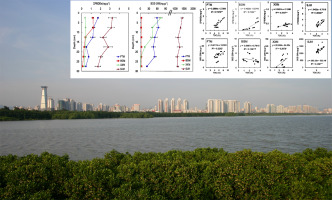Science of the Total Environment ( IF 8.2 ) Pub Date : 2018-07-20 , DOI: 10.1016/j.scitotenv.2018.07.278 Minwei Chai , Ruili Li , Cong Shi , Xiaoxue Shen , Rongyu Li , Qijie Zan

|
Mangroves are threatened due to urban development and human activities in coastal regions. Four urban mangroves in Shenzhen (rapidly developing city of China) were selected according to urban functional zoning, namely, Shajing mangrove (SJM) and Xixiang mangrove (XXM) featured with industry district, Futian mangrove (FTM) and Baguang mangrove (BGM) featured with central business district and ecological preserve. Eight BDE congeners (BDE-28, -47, -99, -100, -153, -154, -183, and -209) in mangrove sediments and leaves were determined. The highest level of BDE-209 in SJM was proximate to areas of point-source discharges of Dongbao River in Pearl River Estuary, China. Total organic carbon (TOC) was influential in BDE-209 accumulations in SJM, XXM, and FTM. Multiple variate analysis implied that PBDEs in SJM, XXM and FTM mainly composed of penta-, octa-, and deca-BDEs, with surface runoff to be the main contamination sources; while BGM was contaminated by penta- and octa-BDEs. Ecological risk of BDE-209 was high in SJM, with medium/negligible risk in the other urban mangroves. The transfers of BDE-209 from sediment to leaf were weak (BGM and FTM), improved (XXM), and restricted (SJM), respectively. This is the first reports of spatial distribution and bioaccumulation of PBDEs in urban mangroves featured with different urban functional zonings. More attention is required to reduce emission of PBDEs into the environment and manage PBDEs contamination in urban mangroves.











































 京公网安备 11010802027423号
京公网安备 11010802027423号